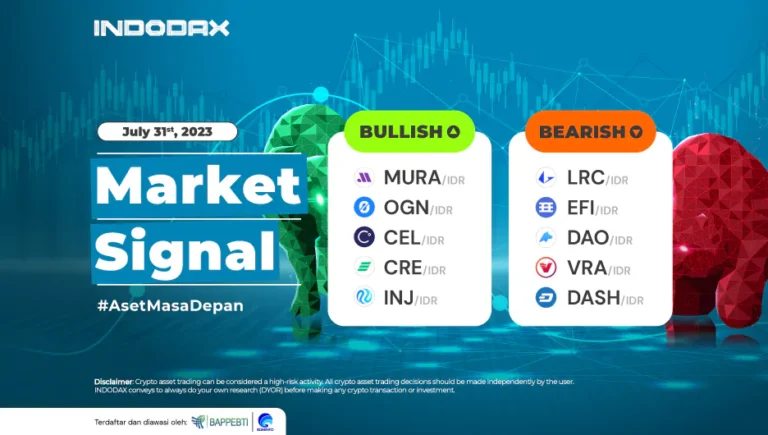The term flag pattern, or what is commonly called the flag pattern, is one of the most popular chart patterns in financial market technical analysis. Or it could be interpreted as a rest period for the market before moving further.
When this pattern appears after a strong price movement, traders look for opportunities to re-enter the market, waiting for confirmation that the price will move further.
The pattern is divided into two, namely, the bearish and bullish flag patterns.
The bearish flag pattern is a significant price pattern for traders and investors to know and pay attention to for stocks, crypto, and other investment assets.
Meanwhile, the bullish flag pattern occurs when a strong price movement occurs and is followed by a relatively stable period of price consolidation, followed by another strong upward price movement.
In this article, we will explore what a bearish flag is and how to use it in trading analysis, see the full review below.
What are Flag Patterns?
As mentioned earlier, a flag pattern is a pattern on a price movement chart in the market that is used to monitor the possibility of continuing a market trend that occurred before.
At first glance, this pattern, in line with its name, is almost the same as a flag or flagpole.
The flag section will identify sharp price reversals, while the flagpole section will indicate price movement trends for a relatively short period.
Through this pattern, traders will know the right time to enter the market amid an ongoing trend.
What is the Bearish Flag Pattern?

The bearish or bear flag pattern is a pattern that indicates a downward trend in market prices.
When the price is in a downtrend, this pattern will show a slow consolidation higher after an aggressive downtrend.
This suggests that more selling pressure drove the price downwards than upwards and suggests that the momentum will continue in the downtrend.
It should be noted the bearish flag pattern is also a signal for sellers to continue selling, but at the same time serves as a warning to potential buyers, so they don’t rush into buying.
How to Recognize the Bearish Flag Pattern
Recognizing this pattern is relatively easy if the trader understands its components.
This also applies to all financial markets. This pattern is divided into three parts, namely the pole, flag, and breakdown.
These three components must exist to form a complete pattern. The following are points regarding how to recognize the bearish flag pattern.
1. The pole is formed after a downward price movement (downtrend)
Thus, several highs and lows are getting lower and lower (lower lows & lower highs).
After the new low occurred, the price movement began to rebound because the sellers took a breather.
2. The occurrence of price consolidation
Furthermore, price movements will experience limited consolidation, which forms parallel channels, such as a flag being held by a team of flag raisers before being raised on a pole.
3. The price movement is back down
The buyers took advantage of the consolidation phase to weaken the momentum of the sellers.
Meanwhile, sellers took a moment to regain their profits and prepared to push prices even lower.
4. Pattern formation
Usually, the consolidation phase in this pattern only lasts for a short time.
Price rebounds generally don’t go past the 50% Fibonacci Retracement level of the pole that has been formed.
After the consolidation ends, the price movement should fall again, starting around the 38.2% Fibonacci retracement level.
5. Breakout occurs below support
The pattern is legally formed after the price drops to break down the previous low level.
The shorter the rebound, the stronger the ongoing bearish pressure, and the stronger the breakdown.
Accurate Bearish Flag Pattern
This pattern has a fairly high accuracy as long as the following three conditions are met, namely:
- Bearish flags exist in the middle of a downtrend, not in market conditions that go up and down sideways with a wide enough range (choppy).
- Has a complete component consisting of a pole, flag, and breakdown.
- The consolidation phase did not last too long, and the price increase on the rebound did not reach more than the 50% Fibonacci retracement level.
Advantages of the Bearish Flag Pattern
The bear flag signals that the price will decline after the consolidation period ends.
Therefore, the bear flag is handy as a signal for short selling to traders or futures contracts.
In this case, there is a compelling risk/reward ratio for the trader who has put a sell position after this bullish flag pattern ends.
So, if this pattern only appears after you buy a stock or crypto asset, how about it?
As a trader in the above situation, we recommend that you consider cut losses.
Meanwhile, investors can consider whether the asset can hold longer or cut losses if the asset does not have good fundamentals.
Disadvantages of the Bearish Flag Pattern
The most visible drawback of the bearish flag is the uncertainty of price movements after the consolidation phase.
Related to this, the sellers may lose momentum in this phase so that the buyer side succeeds in pushing for a further price rebound and then triggers a trend change from bearish to bullish (bullish reversal).
To avoid being fooled by an unconfirmed bear flag pattern, it’s a good idea to execute orders for short-selling or cut losses only if the price movement has actually experienced a breakdown from the low level that was previously marked.
Trading Tips Using the Bearish Flag Pattern
To detect a single pattern, the first step that can be taken is to look for assets that are experiencing a downtrend.
Then, when there is a rebound in the descending trend channel, measure the degree of the ongoing bullish correction.
As mentioned earlier, to form an accurate bearish flag, the price increase on the rebound should not be more than the 50% Fibonacci Retracement level from the tip of the pole.
If the rebound occurs for a long time, you may have to draw a Fibonacci retracement as an analysis tool.
However, if the rebound only occurs briefly, the pattern may be immediately detected without other tools.
Conclusion
In conclusion, a bearish flag is a pattern that indicates a downward trend in market prices.
When the price is in a downtrend, this pattern will show a slow consolidation higher after an aggressive downtrend.
This pattern is divided into three essential parts: the pole, flag, and breakdown.
Furthermore, a bearish flag signals that the price will decline further after the end of the consolidation period.
Thus, this pattern will also be handy as a signal for short selling for traders, including in crypto asset investments.
Apart from bearish flags, you can also study other price movement chart patterns, for example, the flag pattern.
Come on, see also other interesting articles only on INDODAX Academy.








